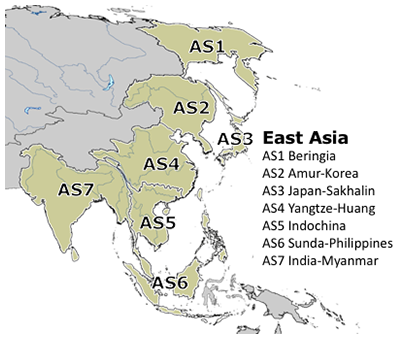| Page last updated
Thu 17 July 2025 |
The Freshwater Mussels (Unionoida) of the World (and other less consequential bivalves)
FM(U)otW(aolcb) is the web version of the MUSSEL Project Database. Follow the links to browse the data or use the custom Google search field. Either way, you win!
East Asia The East Asia Region extends from the Amur River in Russia
south through Japan, Korea, China, Indochina and Indonesia, and west to
include India. East Asia is the most species-rich region on Earth, with
a total of 361 species (91 genera) in three families:
Unionidae,
Margaritiferidae
and Etheriidae. The East Asia Region extends from the Amur River in Russia
south through Japan, Korea, China, Indochina and Indonesia, and west to
include India. East Asia is the most species-rich region on Earth, with
a total of 361 species (91 genera) in three families:
Unionidae,
Margaritiferidae
and Etheriidae.
The East Region is subdivided into seven subregions, each with
a characteristic freshwater mussel assemblage. The low-richness basins
north of the Amur draining into the Bering Sea and Sea of Okhotsk comprise
Beringia (AS1; 3 gen., 3 spp., 0 endemic). The Amur-Korea
Subregion (AS2; 17 gen., 29 spp., 16 endemic ) includes the
Amur Basin and rivers draining to the Sea of Japan and the Yellow Sea,
as far south as the Liao He Basin. Japan, Sakhalin Island, and the
Kuril Islands are group as the Japan-Sakhalin Subregion (AS3; 14 gen., 28 spp., 19 endemic). The Yangtze-Huang Subregion
(AS4; 29 gen., 86 spp., 62 endemic) covers the basins from the
Pei River south through the Qiantang, as well as Taiwan. The area from
southern China to the western Thailand, including the Mekong, is the
Indochina Subregion (AS5; 45 gen., 149 spp., 126 endemic). The
larger islands of Indonesia and the Philippines we group as the
Sunda-Philippines Subregion (AS6; 16 gen., 31 spp., 24 endemic).
The India-Myanmar Subregion (AS7; 20 gen., 82 spp., 77 endemic)
extends from the Salween River in the east to the Indus on its western
frontier. New Guinea is part of the
Australasian Region, and Sulawesi does not seem to have any freshwater
mussels. Endemic species are marked with an asterisk (*). Beringia (AS1)Amur-Korea (AS2)Japan-Sakhalin (AS3)Yangtze-Huang (AS4)Indochina (AS5)Sunda-Philippines (AS6)India-Myanmar (AS7)
|